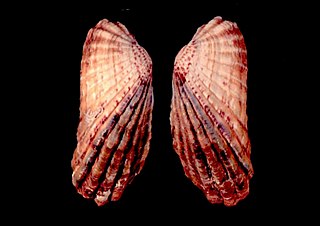Related Research Articles

The Pelagiidae are a family of jellyfish. Members of the family Pelagiidae have no ring canal, and the marginal tentacles arise from umbrella margin.

Zoanthids are an order of cnidarians commonly found in coral reefs, the deep sea and many other marine environments around the world. These animals come in a variety of different colonizing formations and in numerous colors. They can be found as individual polyps, attached by a fleshy stolon or a mat that can be created from small pieces of sediment, sand and rock. The term "zoanthid" refers to all animals within this order Zoantharia, and should not be confused with "Zoanthus", which is one genus within Zoantharia.

The Trochidae, common name top-snails or top-shells, are a taxonomic family of very small to large sea snails, marine gastropod molluscs in the clade Vetigastropoda.
Urosalpinx is a genus of sea snails, marine gastropods in the murex snail family, Muricidae.
Chamalycaeus is a genus of tropical land snails with an operculum, terrestrial gastropod mollusks in the family Alycaeidae.

Corallimorpharia is an order of marine cnidarians closely related to stony or reef building corals (Scleractinia). They occur in both temperate and tropical climates, although they are mostly tropical. Temperate forms tend to be very robust, with wide and long columns, whereas tropical forms tend to have very short columns with a wide oral disc and very short tentacles. The tentacles are usually arranged in rows radiating from the mouth. Many species occur together in large groups, although there are recorded instances of individuals. In many respects, they resemble the stony corals, except for the absence of a stony skeleton. Morphological and molecular evidence suggests that they are very closely related to stony corals.

Pomacea is a genus of freshwater snails with gills and an operculum, aquatic gastropod mollusks in the family Ampullariidae, the apple snails. The genus is native to the Americas; most species in this genus are restricted to South America.
The World Register of Marine Species (WoRMS) is a taxonomic database that aims to provide an authoritative and comprehensive list of names of marine organisms.

Alia is a genus of small sea snails, marine gastropod mollusks in the family Columbellidae, the dove snails.

Thiara is a genus of freshwater snails, aquatic gastropod mollusks in the family Thiaridae.
Eurhamphaeidae is a family of ctenophores.

Nephtheis fascicularis, commonly called the lollipop tunicate, lollipop coral, or blue palm coral, is a species of tunicate that is native to the shallow reefs of Indonesia. It is the only species in its genus Nephtheis. They are not photosynthetic, and live on plankton and small organic particles obtained from the water currents. The branched stems are formed by tiny polyps called zooids.

Carditamera is a genus of molluscs in the family Carditidae.

Trachycardium is a genus of molluscs in the family Cardiidae.
Stilifer astericola is a parasitic sea snail, a marine gastropod mollusk in the taxonomic family Eulimidae. It is the type species of the genus Stilifer.

Meandrina is a genus of colonial stony coral in the family Meandrinidae. Corals in this genus form massive hemispherical heads or have large flat plates and can grow to a metre (yard) across. Sometimes it is referred to as.
Corallimorphus niwa is a species of corals in the genus Corallimorphus. It was classified by Fautin in 2011. Corallimorphus niwa lives in marine habitats.

Concavus is a genus of barnacles.

Diploastrea is a genus of corals. It is the only genus in the monotypic family Diploastreidae.

Haloclava is a genus of sea anemones in the family Haloclavidae. Members of this genus typically burrow into soft sediment.
References
- ↑ Jones, T. R. (1856). "Notes on the Entomostraca (Entomostraca of the Osborne and Hampstead series)". Memoirs of the Geological Survey of Great Britain, 10, pages 157–158.
- ↑ Seguenza, G. (1885). Il Quaternario di Rizzolo (27). II: Gli Ostracodi (24). Il Naturalista Siciliano. 4, pages 295-298